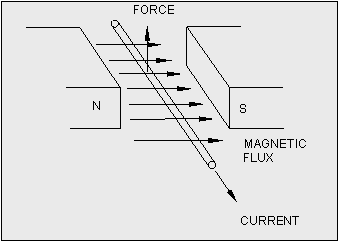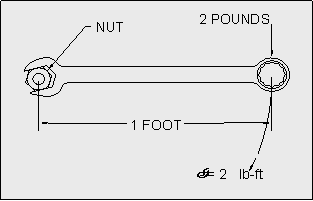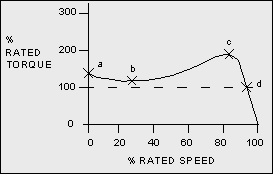Operating Principles
a. Major Parts
All motors have two basic parts:
- The STATOR (stationary part)
- The ROTOR (rotating part)
The design and fabrication of these two components determines the classification and characteristics of the motor. Additional components (e.g. brushes, slip rings, bearings, fans, capacitors, centrifugal switches, etc.) may also be unique to a particular type of motor.
b. Operation
The motors described in this guide all operate on the principle of electromagnetism. Other motors do exist that operate on electrostatic and Piezoelectric principles, but they are less common.
In electric motors, the magnitude of the force varies directly with the strength of the magnetic field and the amount of current flowing in the conductor (Figure 3-1).

Figure 3-1: Force on a Conductor in a Magnetic Field
F = ILB , where
F - Force (newtons)
I - Current (Amperes)
L - Length (metres)
B - Magnetic Flux (webers/m²)
In general, the rotor of an electric motor lies within a magnetic field created by the stator. The magnetic field induces a current within the rotor, and the resultant force caused by the magnetic fields in the stator and rotor (and thus torque) causes it to turn.
c. Motor Power and Torque
The nameplate on electric motors expresses the mechanical power rating in either horsepower or kilowatts.

Two important factors that determine mechanical power output are torque and speed.
Torque is a measure of force that tends to produce a rotation. It is often stated in pound-feet or Newton-metres.
To better understand the concept of torque, consider a large one foot long wrench being used to remove a nut (See Figure 3-2). If one applies 2 pounds of force at the end of this wrench, the torque would be 2 pound-feet. Until the nut starts to turn, no work is actually being performed. When the nut actually starts to turn, work is being performed. Assuming the same force continues to be applied to the wrench handle, the power is essentially the rotational speed times the torque applied.

Figure 3-2: Torque Example
Motor speed is commonly stated in revolutions per minute (RPM).
Motor horsepower is defined as the rotational speed of the motor multiplied by the torque.

The slower the motor operates the more torque it must produce to deliver the same power output. To withstand the greater torque, lower speed motors need stronger components and are generally larger, heavier and more expensive than those of higher speed motors of the same power rating.
There is sometimes confusion with the concept of torque and speed with horsepower. To illustrate the difference, consider the starting motor for an automobile. This specialty motor is designed for high torque but relatively low horsepower. Its sole purpose is to slowly turn the car engine to get it started. Conversely, the motor in a small fan rotates at high speed, but is easily stopped. The latter motor produces low torque. A final example is a 3 HP table saw motor. Shoving a piece of wood into the spinning blade will barely slow the motor down as the motor combines both speed and torque for the application.
d. Torque-Speed Characteristics of Motors
Torque produced by a motor typically varies with speed.
Each motor type has its own torque speed relationship which when plotted as torque vs. speed helps in the selection process (Figure 3-3).

Figure 3-3: Typical Torque-Speed Graph
Some important points found on a torque-speed graph include:
- Starting torque - the torque produced at zero speed. If the motor is to turn a load that is difficult to start (a high inertia load) one would choose a motor with high starting torque.
- Pull-up torque - the minimum torque produced during acceleration from standstill to operating speed. This may be critical for an application that needs power to go through some temporary barriers before achieving the working level output.
- Breakdown torque - the maximum torque that the motor can produce before stalling.
- Full load torque (also braking torque) - the torque produced at full load speed that gives the rated output of the motor. At this point the torque times the speed equals the nameplate horsepower rating.
Previous: Motor Classification | Table of Contents | Next: AC Motors
Page details
- Date modified: